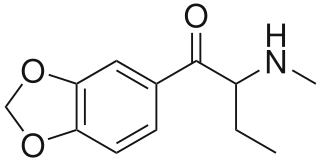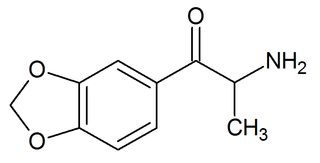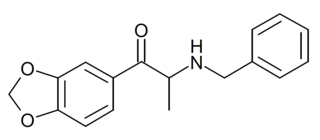
Cathinone is a monoamine alkaloid found in the shrub Catha edulis (khat) and is chemically similar to ephedrine, cathine, methcathinone and other amphetamines. It is probably the main contributor to the stimulant effect of Catha edulis, also known as khat. Cathinone differs from many other amphetamines in that it has a ketone functional group. Other phenethylamines that share this structure include the stimulants methcathinone, MDPV, mephedrone and the antidepressant bupropion.

Butylone, also known as β-keto-N-methylbenzodioxolylbutanamine (βk-MBDB), is an entactogen, psychedelic, and stimulant psychoactive drug of the phenethylamine chemical class. It is the β-keto analogue of MBDB and the substituted methylenedioxyphenethylamine analogue of buphedrone.

Methylone, also known as 3,4-methylenedioxy-N-methylcathinone (MDMC), is an empathogen and stimulant psychoactive drug. It is a member of the amphetamine, cathinone and methylenedioxyphenethylamine classes.

Ethylone, also known as 3,4-methylenedioxy-N-ethylcathinone, is a recreational designer drug classified as an entactogen, stimulant, and psychedelic of the phenethylamine, amphetamine, and cathinone chemical classes. It is the β-keto analogue of MDEA ("Eve"). Ethylone has only a short history of human use and is reported to be less potent than its relative methylone. In the United States, it began to be found in cathinone products in late 2011.
A drug with psychotomimetic actions mimics the symptoms of psychosis, including delusions and/or delirium, as opposed to only hallucinations. Psychotomimesis is the onset of psychotic symptoms following the administration of such a drug.

Substituted methylenedioxy- phenethylamines (MDxx) are a large chemical class of derivatives of the phenethylamines, which includes many psychoactive drugs that act as entactogens, psychedelics, and/or stimulants, as well as entheogens. These agents are used as research chemicals, designer drugs and as recreational substances.

Methedrone is a recreational drug of the cathinone chemical class. Chemically, methedrone is closely related to para-methoxymethamphetamine (PMMA), methylone and mephedrone. Methedrone received media attention in 2009 after the death of two young Swedish men. In both cases toxicology analysis showed methedrone was the only drug present in both men during the time of their overdose and subsequent deaths.

3,4-Methylenedioxycathinone is an empathogen and stimulant of the phenethylamine, amphetamine, and cathinone classes and the β-keto analogue of MDA.

3,4-Dimethylmethcathinone (3,4-DMMC) is a stimulant drug first reported in 2010 as a designer drug analogue of mephedrone, apparently produced in response to the banning of mephedrone, following its widespread abuse in many countries in Europe and around the world. 3,4-DMMC has been seized as a designer drug in Australia. In vitro, 3,4-DMMC was shown to be a monoamine transporter substrate that potently inhibits norepinephrine and serotonin reuptake, and to a lesser extent dopamine reuptake.

Pentedrone is a stimulant of the cathinone class that has been sold as a designer drug and has been found since 2010 as an ingredient in a number of "bath salt" mixes sold as legal highs.
Bath salts are a group of recreational designer drugs. The name derives from instances in which the drugs were disguised as bath salts. The white powder, granules, or crystals often resemble Epsom salts, but differ chemically. The drugs' packaging often states "not for human consumption" in an attempt to circumvent drug prohibition laws. Additionally, they may be mislabeled as plant food, powdered cleaner, and other such products.

5-Methylethylone is an empathogen, stimulant and psychedelic drug of the amphetamine, phenethylamine, and cathinone chemical classes. It is structurally related to ethylone, a novel designer drug. Relatively little data exists about the pharmacological properties, metabolism, and toxicity of 5-methylethylone, though it has been sold as a designer drug.

4-Methylcathinone, is a stimulant drug of the cathinone chemical class that has been sold online as a designer drug. It is a metabolite of the better known drug mephedrone (4-methylmethcathinone).

5-Methoxymethylone is a chemical compound of the cathinone class which has been sold online as a designer drug. It is the beta-ketone version of 5-Methoxy-MDMA. The more common name 2-AIMP/2-A1MP does not appear to relate to the molecular structure. In comparison with methylone, the two compounds differ by the addition of a methoxy group at the 5th carbon atom of the aromatic ring. The toxicity of this compound is unknown.

N-Ethylhexedrone (also known as α-ethylaminocaprophenone, N-ethylnorhexedrone, hexen, and NEH) is a stimulant of the cathinone class that acts as a norepinephrine–dopamine reuptake inhibitor (NDRI) with IC50 values of 0.0978 and 0.0467 μM, respectively. N-Ethylhexedrone was first mentioned in a series of patents by Boehringer Ingelheim in the 1960s which led to the development of the better-known drug methylenedioxypyrovalerone (MDPV). Since the mid-2010s, N-ethylhexedrone has been sold online as a designer drug. In 2018, N-ethylhexedrone was the second most common drug of the cathinone class to be identified in Drug Enforcement Administration seizures.

Isohexylone is a recreational designer drug from the substituted cathinone family, with stimulant effects. It was first identified in the United Kingdom in June 2019.

BMAPN (βk-methamnetamine) is a substituted cathinone derivative with stimulant effects. It inhibits dopamine reuptake and has rewarding and reinforcing properties in animal studies. It is banned under drug analogue legislation in a number of jurisdictions. The drug was at one point marketed under the name NRG-3, although only a minority of samples of substances sold under this name have been found to actually contain BMAPN, with most such samples containing mixtures of other cathinone derivatives.

Dimethylone (βk-MDDMA) is a substituted cathinone derivative with stimulant and empathogenic effects. Unlike the corresponding amphetamine derivative MDDM which is thought to be practically inactive, dimethylone substitutes for methamphetamine and MDMA in animal studies and has been sold as a designer drug.

Benzylone, is a recreational designer drug from the substituted cathinone family, with stimulant effects. It has been commonly encountered in seizures of street drug samples but appears to have relatively low potency on its own, being mainly found as a component of mixtures with other related drugs.

MDPEP is a substituted cathinone derivative with stimulant effects which has been sold as a designer drug. It is the longer chain heptyl homologue of the well known stimulant designer drugs MDPV and MDPHP. It was first identified in Sweden in 2019 and has been relatively widely sold, being the most commonly encountered substituted cathinone derivative found in the US in 2020–2021, though it has still not reached the same levels of use internationally as MDPV and MDPHP.


















